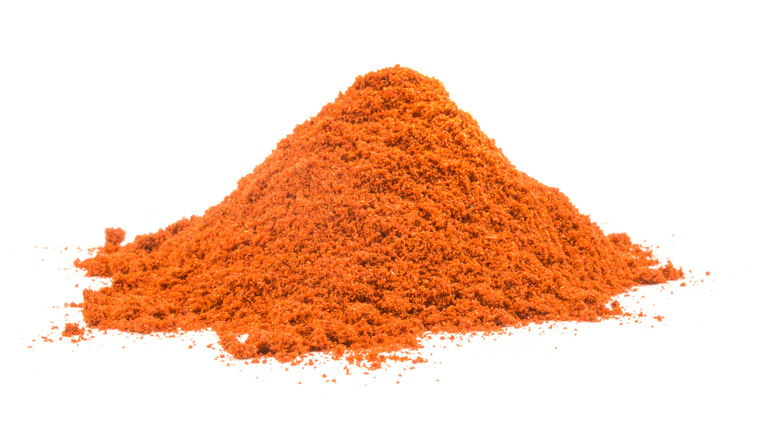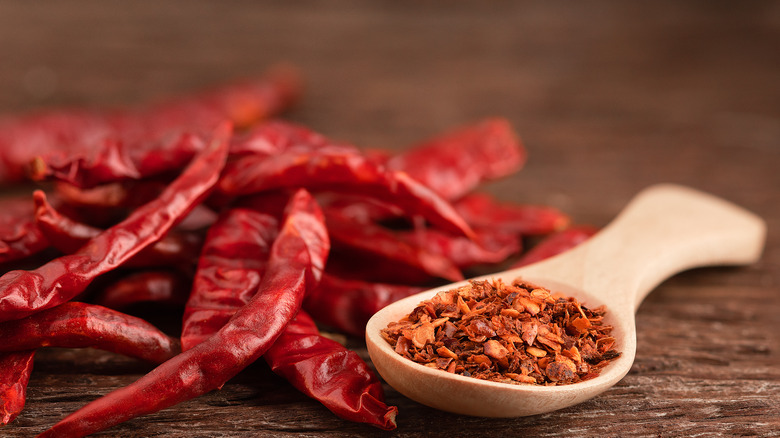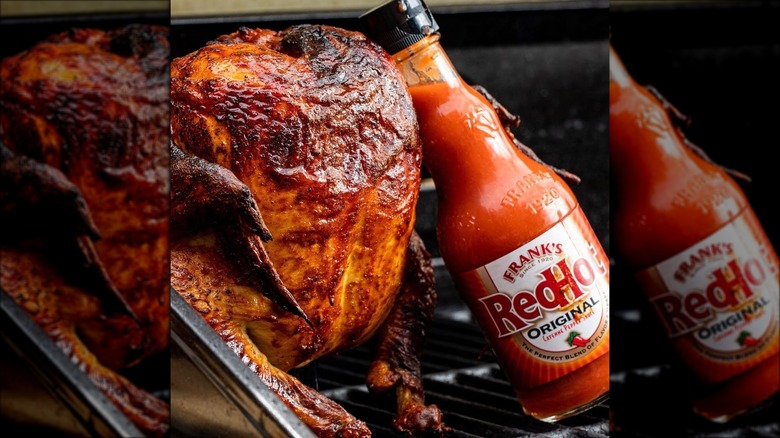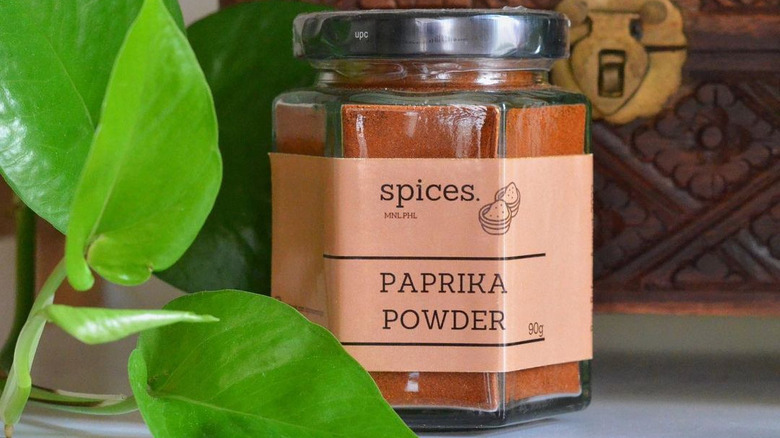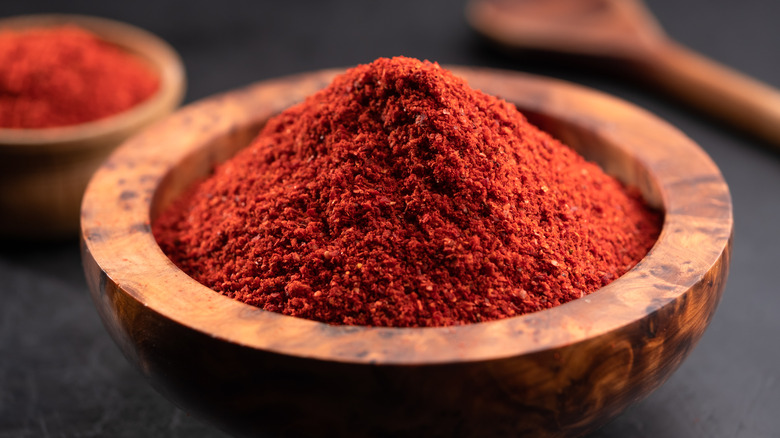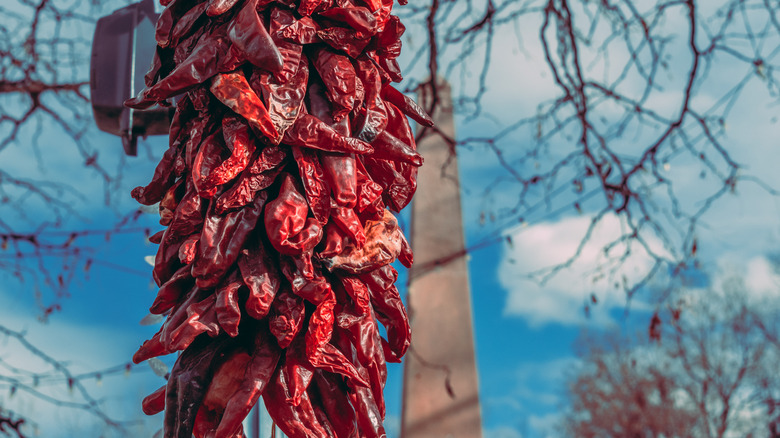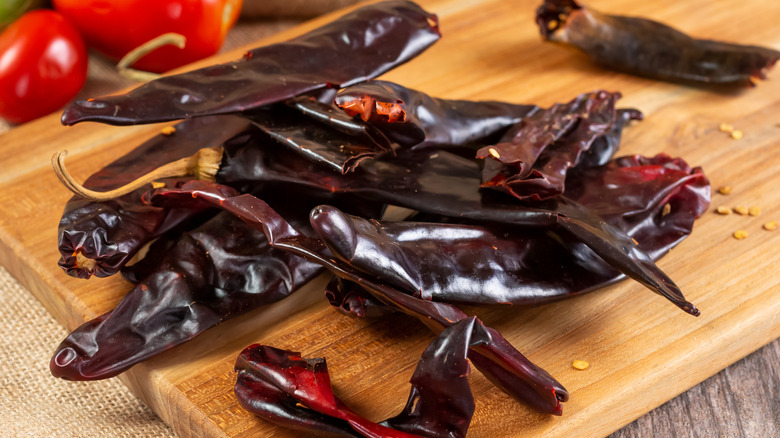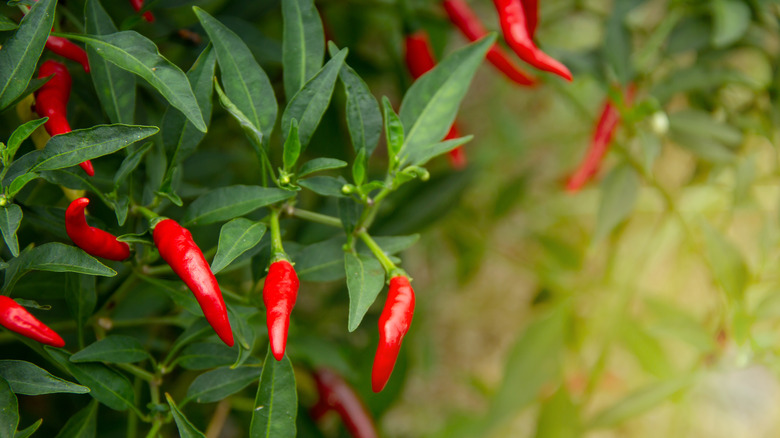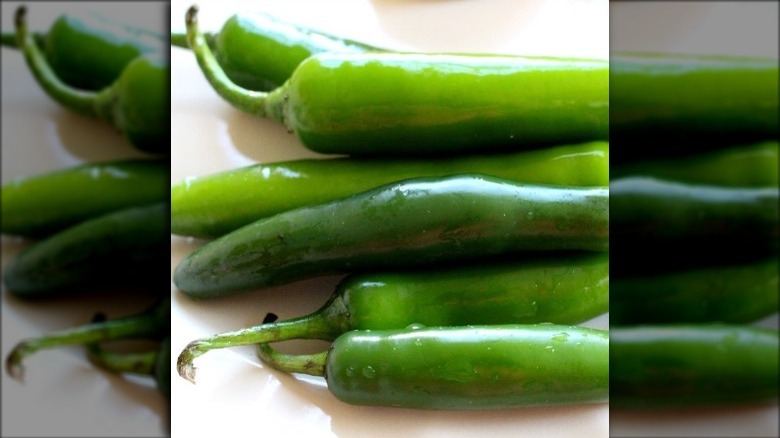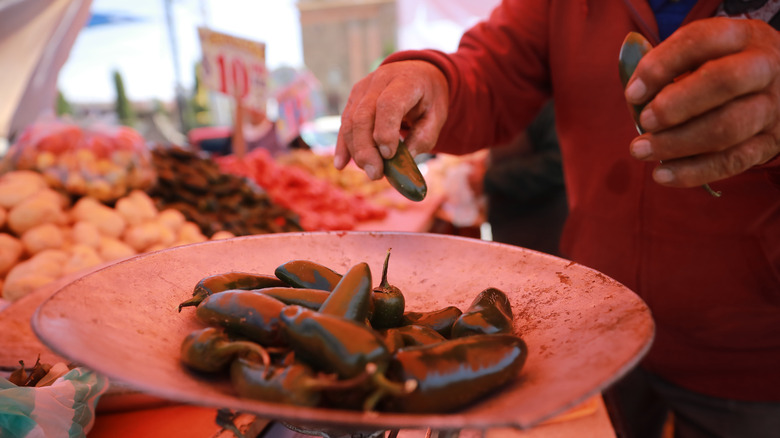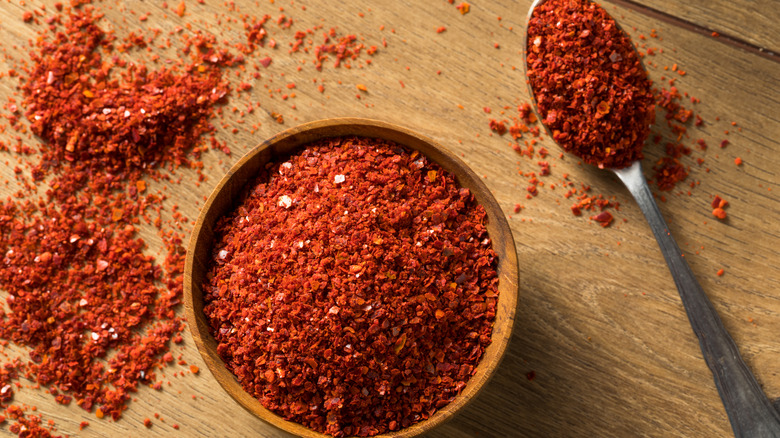10 Best Substitutes For Cayenne Pepper
The dried and powdered form of the cayenne chili pepper (Capsicum annuum) is a spice rack workhorse, trotted out pretty much any time a recipe calls for heat. Cayenne's popularity may be due to its status as a Goldilocks pepper — not too spicy, like the habanero, and not too mild, like the jalapeño. Of course, everyone's spice tolerance is different, but cayenne, at 30,000 to 50,000 heat units on the Scoville scale, is commonly described as having "medium" heat (via PepperScale).
Another reason cayenne is such a versatile kitchen staple is its flavor profile. There's nothing fancy about cayenne's flavor. PepperScale describes it simply as neutral and peppery. SPICEography noted that cayenne definitely has a strong, pungent bite to it, but it serves more to enhance the flavors of other ingredients in a dish, rather than bring its own. Cayenne's uses are practically limitless. It shows up in Mexican, Indian, and Cajun dishes; is used on meats and seafood; and is found in casseroles, salads, barbecue sauce, and even hot chocolate.
While cayenne may seem indispensable, you shouldn't lose all hope for your recipe if you suddenly find yourself out of the spice. While no substitute can be expected to reproduce cayenne's features exactly, several do stand in admirably for the fiery red chili pepper. You just need to be prepared to experience different flavors and adjust your quantities when selecting from this list of the best substitutes for cayenne.
1. Crushed red pepper
If any hot, dry spice is more ubiquitous than cayenne in the United States, it might be red pepper flakes, sometimes referred to as crushed red pepper. If you've ever ordered a pizza, you've probably seen crushed red pepper in a glass shaker next to the parmesan. You might even have a container of red pepper flakes on hand in your kitchen to shake over spaghetti or liven up a soup. If so, then you're in luck if you're looking for a good substitute for cayenne. The mix of peppers found in pre-packed red pepper flakes varies a little by brand, but usually, the bulk of the mix is comprised of cayenne.
Grow Hot Peppers says to replace cayenne pepper with the equivalent amount of crushed red pepper, or up to 1.5 times more crushed red pepper than the amount of cayenne called for in the recipe. Another thing to keep in mind when substituting crushed red pepper for cayenne in a recipe: Cayenne powder may add color to a dish, but crushed red pepper will add texture and will even be visible in your finished product. If you substitute crushed red pepper for cayenne, you won't be able to hide that fact from your guests.
2. Frank's RedHot
If texture and appearance are important, and crushed red pepper is not the best substitute for cayenne pepper in your dish, then you might consider a liquid alternative. A number of hot sauces can work as a cayenne substitute, but if you want to stay true to the cayenne experience, one of your best bets is going to be Frank's RedHot. Frank's sauce is made from aged cayenne peppers. Tabasco would also work as a cayenne substitute, too, even though it is made with tabasco peppers and is more vinegary than Frank's.
When measuring, a good rule of thumb is to replace one-half teaspoon of cayenne with eight drops of hot sauce, per Grow Hot Peppers. Depending on which sauce you are using, you'll want to taste as you cook to make sure the flavor and heat level are right for you. Tabasco is hotter and more vinegary than Frank's RedHot sauce.
3. Paprika
You may have reached for the cayenne in your spice rack only to read the label and discover you had grabbed the similar looking paprika instead. Once you realize that the cayenne you thought you had in your kitchen was really paprika all along, you might wonder if you can replace the cayenne in your recipe with paprika. The short answer is "yes," but paprika comes in different varieties, so you need to know which kind you're working with before deciding whether it'll work for you as a substitute.
Most paprika bought off store shelves is the sweet kind. It's made from red bell peppers and other mild, sweet varieties, and it brings as much of a spice kick as your standard deviled egg — which, incidentally, is usually sprinkled with the colorful spice. Hot paprika is a blend of sweet and hot chiles that will come closer to cayenne-level heat. In fact, hot paprika often includes some cayenne in its mix. A third type of paprika is smoked, which brings little if any heat but adds a natural smoke flavor.
Grow Hot Peppers recommends doubling the amount of paprika if you're substituting for cayenne, although that will depend somewhat on which type of paprika you're using. As always, taste as you go until you get the desired result.
4. Chili powder
Chili powder is another regular on America's spice racks, and it might be another good candidate as a cayenne substitute. The color is obviously a close match, but does chili powder's flavor work as a cayenne substitute? The answer is a qualified "yes" — as long as you know a couple important details about what, exactly, is in chili powder.
The seasoning is a blend of several spices intended specifically to work in chili con carne, according to D Magazine. The good news first: Cayenne is one of the spices featured in chili powder. The (perhaps) bad news, however, is chili powder typically contains one part cayenne to seven parts everything else — and those other ingredients are going to add their own flavor profiles to your recipe. If your recipe can tolerate the addition of cumin, garlic powder, and oregano, then go for the chili powder. Keep in mind this blend may also contain some salt, and (clearly) chili powder is much less hot than cayenne alone — roughly ⅛ as hot, in fact.
So you have a choice when substituting chili powder for cayenne: Go a lot less spicy, or go a lot more cumin and oregano than you originally envisioned. You can use an equal amount of the spice if you want, as it is less spicy but just as flavorful. Just keep in mind that these other flavors will show up in the dish as well and adjust accordingly.
5. Chile de árbol
Another great dried pepper to replace cayenne with is the chile de árbol. If you've never eaten one of these bright red chiles, you may have seen the small, skinny peppers in decorative garlands called ristras (via The Spice House). Chiles de árbol score between 15,000 and 30,000 on the Scoville scale, says PepperScale, making them roughly half as hot as cayenne.
Making a simple 1:1 swap of powdered chile de árbol for cayenne would work well for guests who might be a little heat-averse. However, you should know that chile de árbol is more flavorful than cayenne, with a nutty, almost smoky profile and a hint of grassiness, so (like with chili powder) you may need to decide between less heat or more unexpected flavor in your dish.
6. Guajillo
A second type of chili pepper that is a good substitute for cayenne is guajillo. These chiles are called "little gourd" in Spanish for the rattling sound their seeds make when you shake the dried peppers (via The Spice House). They are milder than chiles de árbol, says MasterClass, with about as much heat as jalapeño peppers at 2,500 to 5,000 Scoville heat units; so guajillos would work great as a cayenne substitute for all levels of spice tolerance. (You can always put out a shaker of crushed red pepper for guests with bolder tastes.)
Again, as with chile de árbol, guajillo brings a whole new dimension of flavor that cayenne doesn't offer. MasterClass describes the pepper as sweet, fruity, and smoky, with notes of berries and tea; The Spice House mentions cranberry and tomato flavors specifically. While cayenne might be the standard when you want to add spice to your chocolate, Serious Eats suggests that cayenne is the boring option in this scenario and recommends using guajillos instead.
Keeping the heat and flavor variations in mind, you can substitute guajillo for cayenne at a 1:1 ratio.
7. Thai peppers
If you're not afraid of substituting an even spicier chile pepper for cayenne, then Thai peppers are a good option. PepperScale explains that both have a subdued flavor that doesn't interfere with the other ingredients in a dish.
Red Thai chiles are often sold as whole, fresh peppers and might be hard to find in dried, powdered form — especially compared to the more common cayenne. If you happen to have fresh Thai peppers, you can substitute one to two tablespoons of fresh pepper for every tablespoon of powdered cayenne, according to Grow Hot Peppers. Again, taste your dish during preparation to make sure you're getting the desired spice level.
Since Thai peppers are roughly twice as hot as cayenne, you'll either want to cut the ingredient amount in half when substituting Thai chiles, or else let everyone know that they're in for an extra kick.
8. Serrano
Serrano peppers check a lot of boxes when it comes to a good substitute for cayenne. If left on the vine to ripen and turn red, serranos reach Scoville levels of 10,000 to 25,000, making them about half as hot as cayenne peppers (via Specialty Produce). Serranos are slightly sweet, acidic, and earthy in flavor, which isn't too jarringly different from the neutral cayenne.
The only problem with serrano as a substitute for cayenne is that you're not likely to find serrano in powdered form, which is how many people keep cayenne in their spice racks. The peppers are usually sold fresh, dried, or canned, according to The Seattle Times. If your dish will still work if you substitute fresh serranos for cayenne powder, then keep in mind that serranos' heat will permeate the food more and more, the longer you allow the peppers to cook with the other ingredients (via Blend of Bites).
As with Thai peppers, Grow Hot Peppers recommends using one or two parts fresh pepper for every one part cayenne powder that's called for in the recipe.
9. Jalapeño
Jalapeños are in the same category as serranos: a chile that's not as hot as cayenne and is likely to be found at the store or farmers market fresh, not powdered. Red jalapeños are harder to find than the more common green versions, unless you happen to be in Texas, where the red jalapeño is the state pepper (via Specialty Produce). The red jalapeños top out at 10,000 Scoville heat units, which means the hottest ones have roughly ¼ the heat of cayenne peppers. In general, though, jalapeños should be considered a much milder substitute for cayenne, which is about 12 times hotter than the average jalapeño.
When dried and smoked, red jalapeños make chipotle peppers, which can be found ground into a powder, says Specialty Produce. With a smokier flavor and more brown color than cayenne, Blend of Bites recommends only using chipotle powder as a cayenne substitute if your dish would do well with that flavor. This smokiness works especially well with dark chocolate.
Because of the heat difference, Pepper Geek recommends doubling the amount of jalapeño you're using when substituting for cayenne.
10. Gochugaru
Korean food has a hot-spice staple as common as cayenne is in the U.S., says Chili Pepper Madness, called gochugaru. It is a dried spice made from Korean chiles that has a rougher texture, somewhere between powdered cayenne and standard red pepper flakes. Unlike crushed red pepper, gochugaru generally doesn't contain seeds, so it's a uniform bright red in color. If it's labeled "taeyangcho," that means the peppers were sun-dried, which is PepperScale explains to thought to bring better color and heat to the spice.
Gochugaru packs anywhere from 1,500 to 10,000 Scoville heat units, which makes it decidedly milder than cayenne. The Korean spice is also more flavorful than cayenne, described by PepperScale as fruity and smoky.
Still, if you're willing to explore other flavors with your dish, you might want to give gochugaru a try. Since it is milder than cayenne, you can go ahead and load up your dish with the Korean spice when using it as a cayenne substitute, starting with a 1:1 ratio and tasting as you go.
Gochugaru is readily available at many stores or online; the mainstream spice brand McCormick even offers a version of gochugaru, which is labeled "Korean-style red pepper," as seen on the brand's website.
